Here’s a summary of what you’ll learn in this article:
1. Preface: Agile requirements and prototyping with iRise
| Sponsored by: 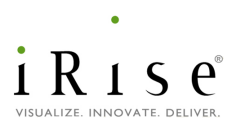
|
2. Why projects so often fail
3. The age of the customer: 6 reasons why prototyping is essential
4. What is iRise? How is it different? Why does it matter?
5. Prototyping, requirements and the Business Analyst
6. Prototyping, requirements and the Development Team
7. No more silos! Integrate your software delivery tools
8. Alignment and clarity now! Virtually end rework and build better software.
Preface: Agile Requirements + Prototyping with iRise
iRise is a requirements gathering and validation platform that’s based on collaborative prototyping. The ability to both manage and validate requirements is what sets iRise apart from other RM tools.
Watch the 3 minute iRise overview
Teams can collaborate in real-time and create, interact with and validate business requirements, and then manage them through to development. The “define and design” process is driven by your interactive prototypes, along with the customizable requirements, user stories and documentation that live alongside them (see demo video above).
You can also integrate iRise with the other tools you already use, like JIRA or Microsoft TFS. This can dramatically improve the productivity of all your teams - giving everyone real-time updates as changes are made throughout the lifecycle.

Why Projects So Often Fail
While organizations have become better at building and delivering faster, they still haven’t cracked the code on figuring out what to build.
— Forrester Research, TechRadar™ Modern Software Requirements Management
Delivering business applications to market faster, with lower cost and a great user experience, are universally common goals. Yet most companies struggle to meet these goals - in part because of the tools they’re using. Business people fundamentally have a hard time understanding functional specifications, static screenshots, use cases and complex business flow diagrams. This fact has long been a pain point, and the data is clear - users can’t accurately interpret text specification, and as a result “inaccurate requirements gathering” remains a primary cause of project failure.
Text alone is no way to define today’s complex & highly-interactive applications.
AGILE OR NOT, PROJECT SUCCESS RATES HAVE PLATEAUED
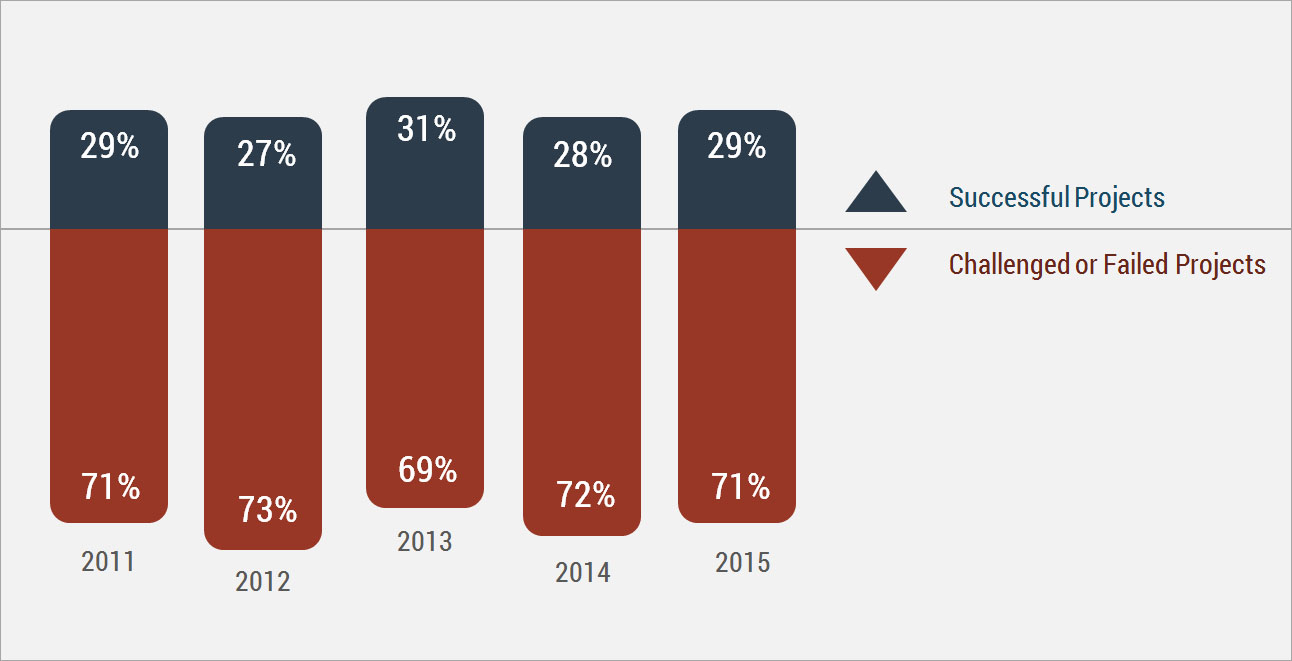
Project resolution results based on the 2015 Standish Group CHAOS Report
Stakeholder review meetings and scrums can be painful as teams try to interpret everything from complex text specifications to simple post-it notes.
The industry has tried two solutions:
Detailed specifications: Text alone is a poor way to describe interactive applications. To compensate for this fact, long and complex requirement documents are often produced. These docs have proven to be nearly impossible to understand - for the business, the stakeholders, and the development team.
It’s common for business people to sign off on specification documents without serious review. You may even hear them say, “I’ll know it when I see it,” which guarantees that after the developers deliver the application, you’ll also hear them say, “That’s not what I wanted...”
How iRise helps: Using iRise will give stakeholders a clear understanding of what you’re proposing, so they’ll “know it when they see it” during the definition phase, before development! You’ll reduce your reliance on documentation and rely more on interaction, constant feedback and collaboration.
Agile: A VersionOne study found that 94% of organizations surveyed now practice some form of Agile (or at least think they do). This trend has moderately improved outcomes, but serious challenges remain...
Design thinking, Agile, and Lean methodologies all share one common goal: a continuous feedback loop. However, the common Agile toolsets don’t make it easy to get reliable feedback on user stories. Thus the need to “prototype in code” and then see if their assumptions hit the mark (and then rinse and repeat). This ends up creating wasted time and effort.
Even in the most Agile of environments, there’s still a certain amount of upfront definition, design and scoping that needs to be done. We’ve seen organizations that try to institute an Agile process by taking the 400-page spec and just chopping it into 400 one-page specs and called those user stories. Many companies are still struggling because they’re using scrum and sprints, but find it difficult to figure out where all the requirements go.
Another challenge with Agile is building the product backlog. Product managers need to find the perfect intersection of user needs, technical feasibility, and business goals to build successful products.
How iRise helps: Using iRise in your Agile process will give teams the clarity they need.
- You’ll create a clear product vision, and understand that your vision will meet your customer's needs
- You’ll provide the team with an easy to use collaboration platform where they can get “continuous feedback” from stakeholders
- You’ll build the right product backlog, and groom and prioritize it correctly along the way
- You’ll discover missing functionality that didn’t exist in your initial designs
- You’ll give developers a clear understanding of what to build and reduce the time they waste on failed concepts
Ultimately, you’ll give your Agile teams the tools they need to be truly…. “agile.”
The Age of the Customer: 6 Reasons why Prototyping is Essential
Good design is no longer optional. User experience is now a key factor shaping how companies do business. Increasingly, there’s a huge gap between businesses that embrace UX strategies and those that don’t.
Forrester’s “Age of the Customer” Timeline
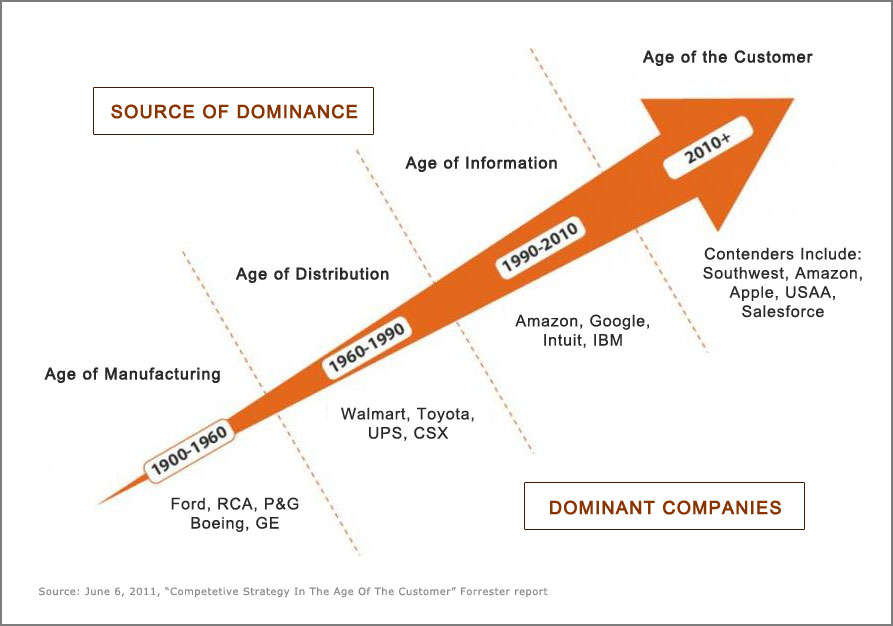
The Age of the Customer is here, and it demands great UX
Forrester has detailed the “Age of the Customer” and how empowered buyers now demand a new level of attention. Forrester rightly points out that the competitive barriers of the past (like manufacturing strength, distribution power, or analytics) aren’t enough. These past differentiators have been commoditized.
Customers have tremendous power now:
- Social outlets and with consumer product reviews give easily obtained insight into how applications perform
- They know your competitors, and how they stack up against you
- Pricing is easily attainable and comparable
- Free trials allow them to ensure an application will meet or exceed their needs before they commit to purchasing
This new found power has rewarded companies that provide applications with great UX, and punished those who don’t. Watermark Consulting studied the impact that focusing on customer experience can have on a business using the Forrester's "Customer Experience Index." They found a dramatic difference in the stock performances of the UX leaders vs the laggards.

UX leaders outperformed the broader S&P 500 Index by 35 points. UX laggards total return was 45 points lower than the broader market.
Investing in a better customer experience has gone from a troublesome business cost to a revenue generator. In the Forrester report on the business impact of customer experience, they site this example from Sprint:
Sprint focused on eliminating the root causes of customer calls to its contact center and moved from last to first in the American Customer Satisfaction Index. As a result of fewer outsourced calls and fewer customer credits, the company saved $1.7 billion per year...
— Forrester Research, The Business Impact of Customer Experience
The end goal is building the best possible solution to meet your stakeholder’s needs. Providing the ability to test-drive proposed solutions, using collaborative prototyping, will help ensure that you do.
Here are 6 reasons why combining prototyping with text requirements is now an essential part of building applications:
- Research from Forrester shows that, on average, every dollar invested in UX brings 100 in return
- Good UX is a process - it requires hands-on testing, feedback and iteration
- The less you leave “open to interpretation” the better
- You need something tangible to show stakeholders to get actionable feedback
- Prototyping gives everyone on a team a single source of truth to work from - it’s a far more effective way to communicate intent than text-based user stories or use cases, or even a group of static screenshots
- For every problem, there are an infinite number of solutions - prototyping offers the ability to explore them, eliminate the ineffective ideas and build the best options
Once you integrate prototyping into your requirements gathering process, you’ll quickly understand whether your proposed solutions solve your customer's problems.
Being agile and iterating fast will help you land on the right solutions - which is a necessity in the age of the customer. They demand it.
What is iRise? How is it different? Why does that matter?
Unlike other requirements management tools, iRise does not use text as the main form of communication. With iRise, you’ll still create and manage text requirements and user stories, but they’ll live alongside a prototype of the functionality and vision they describe. This makes them easier to create, manage, validate, and ultimately be used by development to build from.
The ability to both manage and validate requirements is what sets iRise apart from other RM tools.
Here are some highlights:
Assemble interactive web and mobile prototypes in minutes Before painstakingly documenting hundreds or thousands of written requirements, or creating a product vision, capture them visually with an interactive prototype.
From lo-fi wireframes to hi-fi prototypes With iRise you pick the fidelity level. You can create lo-fi wireframes to help sketch out process flow, hot-spot driven prototypes that provide more fidelity and interaction, or hi-fi apps that include data and logic which will mirror the final application you intend to build.
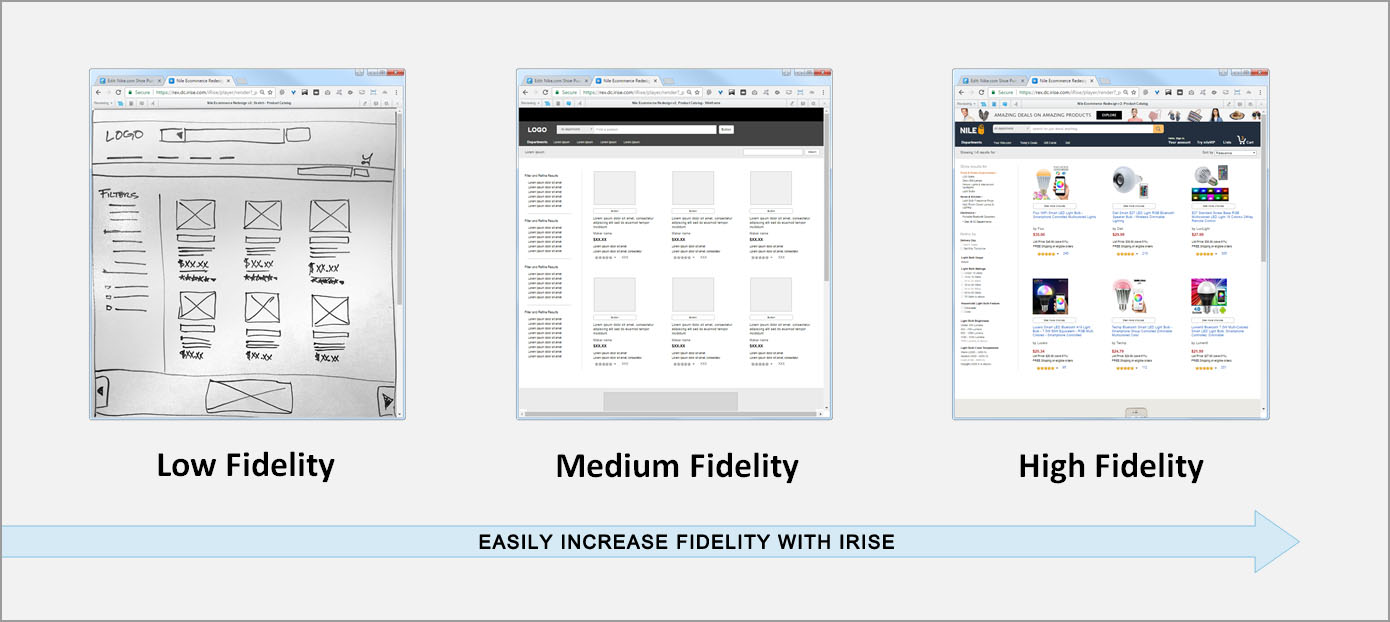
Interactions - animations - data - logic Add microinteractions, navigation, media, rich interactions, business logic, and sample data for a true app experience. Validate a login attempt, search a catalogue, sort a dynamic list, process an order, calculate a total, and more…all without a line of code.

Create interactions, data and logic-driven functionality
Build fast using global asset libraries Assemble prototypes from a large collection of templates, media, icons, branded UI elements, interactive widgets, and more. You can also customize these libraries to suit your needs or create your own.

Create wireframes and prototypes fast using iRise’s unique tools
Go mobile with libraries, touch events, and on-device review Create realistic mobile prototypes of smartphone and tablet apps that look and act like the real thing from a full library of mobile UI controls. Run prototypes directly on the iPhone or iPad with our free iRise mobile app.
Capture requirements in context iRise is the only tool that combines text requirements with web and mobile prototyping. While using collaborative prototyping to drive early communication and consensus, you can start capturing requirements for each screen and UI element directly within the prototype.
Since requirements are in context of the screens they describe, they’re much easier for stakeholders to consume and understand. And our flexible requirements management tools allows you to manage them through to development.

Drag and drop requirements management Sort, prioritize, filter, and group your requirements, user stories, tasks and other related deliverables in a simple list or grid layout. Customize the rows and columns to track just about anything, from status to sprints to priorities. Drag and drop cards to prioritize them and automatically update their properties.
Create a Scrum or Kanban view when development begins. Assign user stories to developers, add development tasks, and track open issues. Organize all of your project documentation, from the project charter to user personas, or high-level business requirements.
Instant Documentation Writing requirements documents can be painstaking, but it doesn’t have to be. All of the information in your prototypes – every screen, UI element, and requirement – can be exported instantly into the documents that you can customize to meet your specific needs.
Publish and share instantly online for honest, actionable feedback Share projects securely with team members, colleagues, and clients. Stakeholders can comment directly on requirements, screens, and individual UI elements so you get the feedback you need. These comments are also displayed in our requirements management tools, so you can continue the conversation there.
Seamlessly integrate Slack and Skype into your workflow In iRise, the top toolbar shows you which project team members are online or off - want to Slack or Skype someone - just click the icon on their contact card and message away!
An experienced global services team The iRise Services team can be a tremendous asset - providing support and helping ensure you maximize your iRise investment.
Our consultants have worked with companies large and small to improve the process of defining requirements. Services range from training teams (onsite and off) on how to effectively define and manage their requirements, supporting teams in the development of their prototypes, and defining standards and best practices tailored specifically to an organization.
Prototyping, Requirements, and the Business Analyst
iRise gives Business Analysts the tools they need to communicate clearly with both the business and its stakeholders. They use working previews that can be virtually indistinguishable from the final product.
When business analysts uses iRise to elicit and document requirements:
1. The business analyst becomes a powerful weapon to get to the right answer.
2. Prototypes are assembled at light speed. Stakeholders are amazed when BAs can visualize screens, behavior, data interactions and business logic that they can test drive and give feedback on.
3. Stakeholders get a fully immersive, accurate experience when interacting with iRise prototypes. The business analyst gets the right requirements faster and easier. And missing requirements become a rarity.
4. Communication is transformed. Business stakeholders lean forward in meetings. They are engaged and participate actively. Leveraging the iRise platform, the business analyst becomes a master facilitator and a black belt at getting to the right answer faster.
Using iRise, business analysts will help:
- Accelerate requirements definition by at least 50%
- Eliminate long hours of overtime struggling with mountains of documents
- Gain control over the definition process
- Ensure that all the business needs are captured
- Get the recognition they deserve
Collaborative prototyping gets everyone on the same page - fast.
Prototyping, Requirements, and the Development Team
No team suffers more with the challenges of deciphering ambiguous text specifications than IT. Using iRise prototypes + integrated requirements, you can deliver an interactive specification to IT and remove the guesswork. You’ll also dramatically improve the collaboration and interactions between the business and IT.
- IT won’t have to constantly bother designers for the assets they need, or worry that the assets they have are out of date
- iRise integrations with tools like JIRA give the dev team visibility into the interaction design, but also encourages them to give feedback – an important part of the agile process
- The prototype is always updated offering a single source of truth for the entire team to work from. This allows ALL teams to stay more in sync with each other, and waste less time searching…
Teams can iterate until they get the design right. iRise is then used by IT to improve accuracy while shortening the development process.
No more silos! Integrate your software delivery tools
Today there are tools for development, testing, requirements, design, product management, project management, customer service, and DevOps. You can dramatically improve the productivity of your software delivery teams by connecting these tools and giving everyone real-time updates as changes are made throughout the lifecycle.
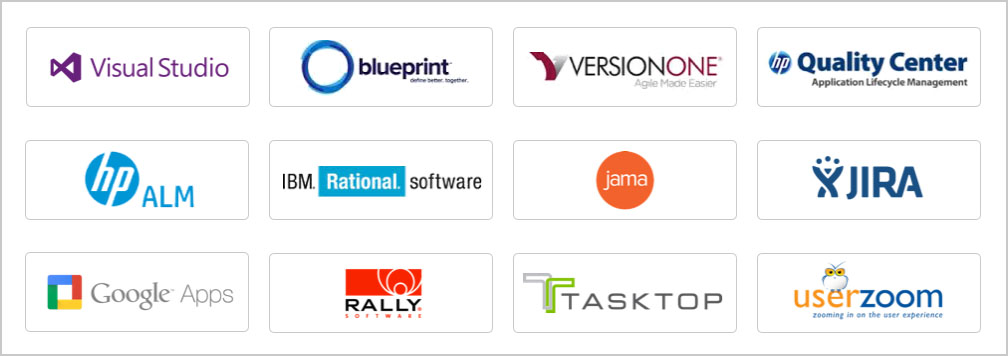
iRise Offers true real-time collaboration with all the leading ALM tools
iRise integrates with all major SDLC platforms, including HP ALM/QC, IBM Rational, Jama, Atlassian JIRA, Rally, VersionOne, Microsoft Visual Studio/TFS, and many others. This means that everyone can see the same accurate information in real time.
Alignment and clarity now! Virtually end rework and build better software.
Ensuring everyone has a clear understanding - from the overall product vision to the smallest microinteraction - is key to project success.
Using iRise in your process will give your teams the clarity they need.
- You’ll understand if you’re vision will meet your customer's needs
- You’ll build the right product backlog, and groom and prioritize it correctly along the way
- You’ll discover missing functionality that didn’t exist in your initial designs
- You’ll give developers a clear understanding of what to build and reduce the time they waste on failed concepts
- You’ll design better software that your users love
Starting with requirements definition, iRise accelerates all phases of the development lifecycle, lowering project costs, rework, and risk. The impact on the business is dramatic…
- Reducing requirements time by up to 50%
- Reducing rework by up to 75%
- Shortening the coding phase by up to 40%
- Improving design and innovation
- Lowering overall project cost by 30%.
With a robust enterprise platform, professional services, cloud hosting and superior customer support, iRise empowers businesses to build applications right the first time, resulting in highly usable products with faster time to market.

CLICK HERE to learn more and start your free iRise trial now.

Author: Dominic Infante, iRise
Dom has been with iRise since day one. From the early days when the concept of “application simulation” was invented by iRise (his name is included on five of its patents), through the development of the product vision and of the product itself. Over 18 years at iRise gives him a unique view of the platform and of the marketplace it leads.